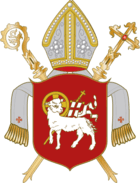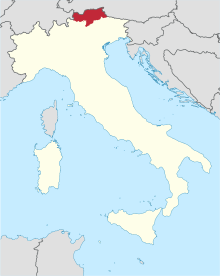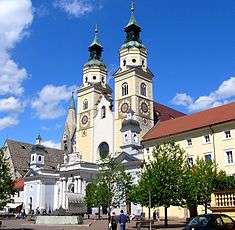Roman Catholic Diocese of Bolzano-Brixen
The Diocese of Bolzano-Brixen (German: Diözese Bozen-Brixen, Italian: Diocesi di Bolzano-Bressanone, Latin: Dioecesis Bauzanensis-Brixinensis) is a Catholic diocese in northern Italy, with its seat in the city of Bolzano. Its territory corresponds with that of the province of South Tyrol with its predominantly German-speaking population. It is a suffragan of the Archdiocese of Trento.[1][2]
Diocese of Bolzano-Brixen Dioecesis Bauzanensis-Brixinensis Diözese Bozen-Brixen Diocesi di Bolzano-Bressanone | |
|---|---|
 | |
| Location | |
| Country | Italy |
| Metropolitan | Trento |
| Statistics | |
| Area | 7,400 km2 (2,900 sq mi) |
| Population - Total - Catholics | (as of 2018) 525,092 501,619 (95.5%) |
| Parishes | 281 |
| Information | |
| Rite | Roman Rite |
| Established | 6th Century |
| Cathedral | Cattedrale di Santa Maria Assunta e San Cassiano (Brixen) |
| Co-cathedral | Duomo di Santa Maria Assunta (Bolzano) |
| Secular priests | 239 (diocesan) 174 (Religious Orders) 29 Permanent Deacons |
| Current leadership | |
| Pope | Francis |
| Bishop | Ivo Muser |
| Map | |
 | |
| Website | |
| www.bz-bx.net | |
The current configuration of the diocese was created by Pope Paul VI, in a papal bull of 6 August 1964, when the South Tyrolean parts of the archdiocese of Trento around Bolzano and Merano were merged into the Diocese of Brixen. In turn, the Austrian parts of the Brixen diocese around Feldkirch, Vorarlberg were at first allocated to the Diocese of Innsbruck and elevated to the Diocese of Feldkirch in 1968; the Ladin districts of Fodom (Livinallongo del Col di Lana and Colle Santa Lucia) and Anpez (Cortina d’Ampezzo) passed from Brixen to the Diocese of Belluno. At the same time the episcopal see was moved to Bolzano, where the Assumption of Mary parish church was elevated to a co-cathedral, while the chapter remained in Brixen.
The diocesan ordinary (bishop) is Ivo Muser, appointed on July 27, 2011 by Pope Benedict XVI.
Bishops
to 1200
- ...
- Altwin (1049–1091 Resigned)
- ...
- Bl. Hartmann von Brixen (1140–1164 Died)
- Otto von Andechs (1165–1170 Resigned)
- ...
- Eberhard de Truxen von Regensberg (1198–1200)[3]
1200 to 1500
- Konrad von Rodeneck (1200–1217)[4]
- Berthold von Neifen (1217–1224)[5]
- Heinrich von Taufers (1224?–1239)[6]
- Egno von Eppan (1240–1250)[7]
- Bruno von Bullenstetten und Kirchberg (1250–1288)[8]
- Heinrich von Trevejach (1290–1295)[9]
- Landulfus (1295–1301)[10]
- Arnoldus (attested 1302)
- Johannes Sax (attested 1303–1306)[11]
- Johannes Wulfing von Güttingen (1306–1322)[12]
- Konrad von Klingenberg (1322–1324 Appointed, Bishop of Freising)
- ...
- Sebastian Stampfel (1417–1418)
- Berthold von Bükelsberg (1418–1427)[13]
- Ulrich Putsch (1428–1437)[14]
- Georg von Stubai (1437–1443 Died)
- Johann Rottel (1444–1450 Died)
- Nikolaus von Cusa (1450–1464 Died)
- Francesco Gonzaga (1464–1466 Appointed, Administrator of Mantova)
- Leo von Spaur (1469–1471 Confirmed, Bishop of Wien)
- Georg Golser (1471–1488 Resigned)
- Melchior von Meckau (1488–1509 Died)
1500 to 1800
- Christoph von Schrofenstein (1509–1521 Died)
- Jorge de Austria (1526–1538 Appointed, Archbishop of Valencia)
- Bernhard von Cles (Clesio) (1539–1539 Died)
- Christoph Fuchs von Fuchsberg (1539–1542 Died)
- Cristoforo Madruzzo (1542–1578 Died)
- ...
- Andreas von Austria (Österreich) (1591–1600 Died)
- Christoph Andreas von Spaur (1601–1613 Died)
- Charles de Habsburg (d'Autriche-Styrie) (1613–1624 Died)
- Hieronymus Otto Agricola (1625–1627 Died)
- Daniel Zeno (1627–1628 Died)
- Wilhelm von Welsberg (1629–1641 Died)
- Johann Platzgummer (1641–1647 Died)
- Anton Crosini von Bonporto (1648–1663 Died)
- Sigmund Alphons von Thun (1663–1677 Died)
- Paulinus Mayr (1678–1685 Died)
- Johann Franz von Khuen zu Liechtenberg (1687–1702 Died)
- Kaspas Ignaz von Künigl zu Ehrenburg (1703–1747 Died)
- Leopold Maria Joseph von Spaur (1748–1778 Died)
- Ignaz Franz Stanislaus von Spaur (1778–1779 Died)
- Joseph Philipp Franz von Spaur (1780–1791 Died)
since 1800
- Karl Franz von Lodron (1792–1828)
- Bernhard Galura (1829–1856)
- Vinzenz Gasser (1856–1879)
- Johannes von Leiß (Leiss) (1880–1884)
- Simon Aichner (1884–1904 Resigned)
- Josef Altenweisel (1904–1912)
- Franz Egger (1912–1918)
- Johann Raffl (1921–1927)
- Josef Mutschlechner (1928–1930 Resigned)
- Johann Baptist Geisler (1930–1952 Resigned)
- Joseph Gargitter (1952–1986 Resigned)
- Wilhelm Emil Egger, O.F.M. Cap. (1986–2008)
- Karl Golser (2008–2011 Resigned)
- Ivo Muser (2011– )[15]
References
- "Diocese of Bolzano-Bressanone {Bozen-Brixen}" Catholic-Hierarchy.org. David M. Cheney. Retrieved February 29, 2016.
- "Diocese of Bolzano–Bressanone" GCatholic.org. Gabriel Chow. Retrieved February 29, 2016.
- Eberhard was already bishop-elect when ordered to return home by Pope Innocent III in May 1198. He was transferred to the diocese of Salzburg on 20 April 1200. Eubel, Hierarchia catholica I, pp. 148 with n. 1; 432 with note 1.
- Bishop Konrad died on 14 October 1217. Eubel I, p. 148.
- Bishop Berthold was already in office in December 1216. He died on 17 July 1224. Eubel I, p. 148.
- Heinrich had been Archdeacon of Aquileia. Bishop Heinrich died on 18 November 1239. Eubel I, p. 148.
- Bishop Egno was transferred to the diocese of Trent by Pope Innocent IV on 8 November 1250. He died on 25 March 1273. Eubel I, pp. 148, 497-498.
- Bruno was Graf von Bullenstetten und Kirchberg (Mooyer, p. 19). He had been a Canon of the cathedral of Magdeburg. He was appointed on 8 November 1250 by Pope Innocent IV. He died on 24 August 1288. Eubel I, p. 148.
- Heinrich had been Dean of the cathedral Chapter of Brixen. On the death of Bishop Bruno, the Chapter requested (postulavit) Canon Otto, who was below the canonical age and still not in Holy Orders. But while the request was under consideration by the Holy See, the Chapter proceeded to elect two candidates: Heinrich, the Dean of the Chapter, and Master Bonoincontro, Archpriest of Verona. All three candidates resigned their pretensions, and Pope Nicholas IV chose (provided) Heinrich on 3 December 1290. Ernest Langlois, Les Registres de Nicolas IV Tome I (Paris: Fontemoing 1905), p. 582, no. 3878. Sinnacher V.1, pp. 11-17. Eubel I, p. 148.
- Landulf of Milan had been Provost of Worms. He was appointed by Pope Boniface VIII on 30 September 1295. He was killed before 26 March 1301. Eubel I, p. 148 with note 4.
- Johannes Sax had been Provost of Berchtesgaden. Eubel I, p. 148.
- Johannes was transferred to the diocese of Bamberg on 16 June 1322, by Pope John XXII. In 1323, he was transferred to Frising. He died on 25 April 1324 Eubel I, pp. 127, 148, 255.
- Berthold had been Provost of the monastery of Neustift (C.R.). He was elected, and provided by Pope Martin V on 11 July 1418. He died on 12 September 1427. Eubel I, p. 148 with note 9.
- Putsch had been a Canon of Brixen. He was elected, and provided by Pope Martin IV. Eubel I, p. 148.
- Moser was born in Bruneck in 1962. From 1987 to 1989 he was an assistant pastor in Dobbiaco. From 1989 to 1991, he was private secretary to Bishop Wilhelm Egger. He studied dogmatic theology in Rome from 1991 to 1995, and then immediately became a lecturer at the Philosophical-Theological University in Brixen to 2002. He became rector at the seminary in Brixen from 1996 to 2012. Pope Benedict XVI appointed him Bishop of Brixen on 28 July 2011, and on 9 October 2011 he was consecrated a bishop by Archbishop Luigi Bressan of Trent. CV of Bishop Muser: Diözese Bozen-Brixen, "Bischof Ivo Muser"; retrieved: 25 June 2020. (in German)
Books
Episcopal lists
- Eubel, Conradus (ed.) (1913). Hierarchia catholica (in Latin). Tomus 1 (second ed.). Münster: Libreria Regensbergiana.CS1 maint: extra text: authors list (link)
- Eubel, Conradus (ed.) (1914). Hierarchia catholica (in Latin). Tomus 2 (second ed.). Münster: Libreria Regensbergiana.CS1 maint: extra text: authors list (link)
- Eubel, Conradus (ed.); Gulik, Guilelmus (1923). Hierarchia catholica (in Latin). Tomus 3 (second ed.). Münster: Libreria Regensbergiana.CS1 maint: extra text: authors list (link)
- Gams, Pius Bonifatius (1873). Series episcoporum Ecclesiae catholicae: quotquot innotuerunt a beato Petro apostolo (in Latin). Ratisbon: Typis et Sumptibus Georgii Josephi Manz. pp. 265–266.
- Gauchat, Patritius (Patrice) (1935). Hierarchia catholica (in Latin). Tomus IV (1592-1667). Münster: Libraria Regensbergiana.
- Ritzler, Remigius; Sefrin, Pirminus (1952). Hierarchia catholica medii et recentis aevi (in Latin). Tomus V (1667-1730). Patavii: Messagero di S. Antonio.
- Ritzler, Remigius; Sefrin, Pirminus (1958). Hierarchia catholica medii et recentis aevi (in Latin). Tomus VI (1730-1799). Patavii: Messagero di S. Antonio.
- Ritzler, Remigius; Sefrin, Pirminus (1968). Hierarchia Catholica medii et recentioris aevi (in Latin). Volume VII (1800–1846). Monasterii: Libreria Regensburgiana.
- Ritzler, Remigius; Sefrin, Pirminus (1978). Hierarchia catholica Medii et recentioris aevi (in Latin). Volume VIII (1846–1903). Il Messaggero di S. Antonio.
- Pięta, Zenon (2002). Hierarchia catholica medii et recentioris aevi (in Latin). Volume IX (1903–1922). Padua: Messagero di San Antonio. ISBN 978-88-250-1000-8.
Studies
- Brackmann, Albert (1911). Germania pontificia Vol. I: Provincia Salisburgensis et Episcopatus Tridentinus. Berlin: Weidmann. (in Latin) pp. 140–153.
- Mooyer, Ernst Friedrich (1854). Oncmasticon chronographikon Hierarchiæ Germanicæ. Verzeichniss der deutschen Bischöfe seit dem Jahre 800 (in Latin). Minden. pp. 19–20.
- Sinnacher, Franz Anton. Beyträge zur Geschichte der bischöflichen Kirche Säben und Brixen in Tyrol. 9 vols. Brixen: Joseph Weger 1821–1835. (in German) [Fraktur]
- Sinnacher, Franz Anton (1822). Beyträge zur Geschichte der bischöflichen Kirche Säben und Brixen in Tyrol. (10th-11th cent.) (in German). II. Band, ii. Heft. Brixen: Weger.
- Sinnacher, Franz Anton (1822). Beyträge zur Geschichte der bischöflichen Kirche Säben und Brixen in Tyrol. (1000-1100) (in German). II. Band, iii Heft. Brixen: Weger.
- Sinnacher, Franz Anton (1823). Beyträge zur Geschichte der bischöflichen Kirche Säben und Brixen in Tyrol. (1100-1200) (in German). III. Band, i Heft. Brixen: Weger.
- Sinnacher, Franz Anton (1823). Beyträge zur Geschichte der bischöflichen Kirche Säben und Brixen in Tyrol. (1100-1200) (in German). III. Band, ii Heft. Brixen: Weger.
- Sinnacher, Franz Anton (1824). Beyträge zur Geschichte der bischöflichen Kirche Säben und Brixen in Tyrol. (1100–1200) (in German). III. Band, iii Heft. Brixen: Weger.
- Sinnacher, Franz Anton (1824). Beyträge zur Geschichte der bischöflichen Kirche Säben und Brixen in Tyrol. (1200-1300) (in German). IV. Band, i Heft. Brixen: Weger.
- Sinnacher, Franz Anton (1825). Beyträge zur Geschichte der bischöflichen Kirche Säben und Brixen in Tyrol: ¬Die Kirche Brixen im 1200 - 1300 Jahrhunderte. (1200-1300) (in German). IV. Band, ii. Heft. Brixen: Weger.
- Sinnacher, Franz Anton (1826). Beyträge zur Geschichte der bischöflichen Kirche Säben und Brixen in Tyrol. (1200-1300) (in German). IV. Band, iii Heft. Brixen: Weger.
- Sinnacher, Franz Anton (1827). Beyträge zur Geschichte der bischöflichen Kirche Säben und Brixen in Tyrol. (13th-14th cent.) (in German). V. Band, i. Heft. Brixen: Weger.
- Sinnacher, Franz Anton (1828). Beyträge zur Geschichte der bischöflichen Kirche Säben und Brixen in Tyrol. (15th cent.) (in German). VI. Band, i. Heft. Brixen: Weger.
- Sinnacher, Franz Anton (1833). Beyträge zur Geschichte der bischöflichen Kirche Säben und Brixen in Tyrol. (1600-1700) (in German). VIII. Band, iii Heft. Brixen: Weger.

